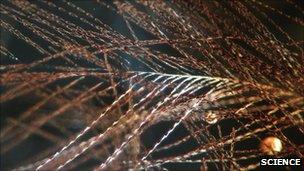Dinosaur feather evolution trapped in Canadian amber
- Published

A wide array of different feather shapes was captured in the same place within just a few years
Samples of amber in western Canada containing feathers from dinosaurs and birds have yielded the most complete story of feather evolution ever seen.
Eleven fragments show the progression from hair-like "filaments" to doubly-branched feathers of modern birds.
The analysis of the 80-million-year-old amber deposits is presented in Science, external.
The find, along with an accompanying article analysing feather pigment, adds to the idea that many dinosaurs sported feathers - some brightly coloured.
Recent years have seen a proliferation of reports about the beginnings of feathers as we know them now in birds.
So-called compression fossils found in China bear outlines of primitive "filament" feathers that are more akin to hair.
But modern feathers are highly branched and structured, and the full story of how those came to be had not yet been revealed by the fossil record.
Now, a study of amber found near Grassy Lake in Alberta - dating from what is known as the Late Cretaceous period - has unearthed a full range of feather structures that demonstrates the progression.
"We're finding two ends of the evolutionary development that had been proposed for feathers trapped in the same amber deposit," said Ryan McKellar of the University of Alberta, lead author of the report.

The team's find confirms that individual filaments progressed to tufts of filaments from a single origin, called barbs.
In later development, some of these barbs can coalesce into a central branch called a rachis. As the structure develops further, further branches of filments form from the rachis.
"We've got feathers that look to be little filamentous hair-like feathers, we've got the same filaments bound together in clumps, and then we've got a series that are for all intents and purposes identical to modern feathers," Mr McKellar told BBC News.
"We're catching some that look to be dinosaur feathers and another set that are pretty much dead ringers for modern birds."
Alexander Wolfe from the University of Alberta, said he was "initially bewildered" by the findings
Lucky find
By the Late Cretaceous, feathers had more or less reached the end of their evolution, and it is simply lucky that specimens bearing the full range of different feather types happened to be captured in the same amber deposit.
"We've known for quite a while that several of the non-bird dinosaurs actually had feathers, and many of them had feathers that are identical to the feathers you see on a pigeon in the park today," said Mark Norell, chairman of the palaeontology division at the American Museum of Natural History, who was not involved in the research.
"What's interesting is the diversity of feathers that were present in [these] non-avian dinosaurs that existed pretty close to that time interval when those animals disappeared around 65 million years ago," he told the BBC.
The most developed of the feathers seem to resemble those of water-dwelling and diving birds - almost like down. However, Mr McKellar said that none of the feathers was adapted for flight, but rather for an ever-more complex ornamentation strategy.

Like the modern grebe's feather here, the latest feathers show adaptations for swimming
A second paper in Science, external examines another aspect of the ornamentation: colour.
Feathers are given their colour by structures in their cells called melanosomes, which contain melanin, the same chemical that produces our skin colour.
Study of remnants of these melanosomes has already yielded evidence, for example, that one of the first feathered dinosaurs ever discovered, the Sinosauropteryx, was a "redhead".
But usually, the melanosomes of feathers, or the melanin they leave behind, are destroyed with time, leaving few clues as to what colour a given dinosaur would have been.
Now Roy Wogelius of the University of Manchester in the UK has developed a method using high-energy rays of light from a synchrotron that can spot tiny amounts of metal atoms left behind by eumelanin, one of the types of melanin responsible for a range of black and brown colours.
"A perfect understanding of colour is unlikely except in perhaps exceptional cases," Dr Wogelius said in an online chat about the work in July, external.
"But with the technological advances, we are optimistic that we will be able to find chemical details beyond simply dark and light patterning."
In fact, a picture is emerging that suggests many dinosaurs were not the dull-coloured, reptilian-skinned creatures that they were once thought to be.
"If you were to transport yourself back 80 million years to western North America and walk around the forest... many of the animals would have been feathered," said Dr Norell.
"We're getting more and more evidence... that these animals were also brightly coloured, just like birds are today."
- Published27 July 2011